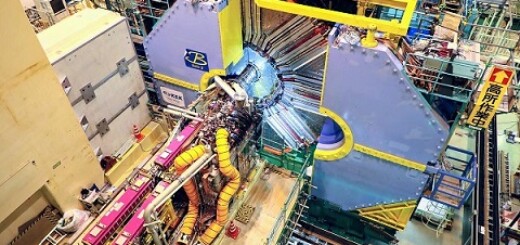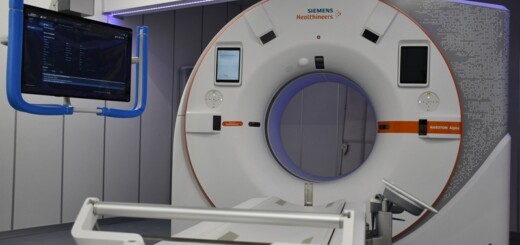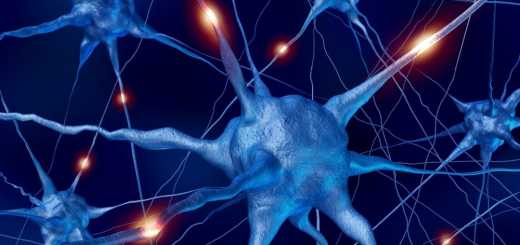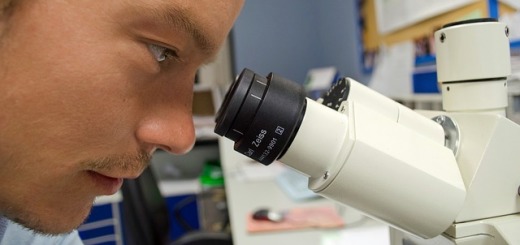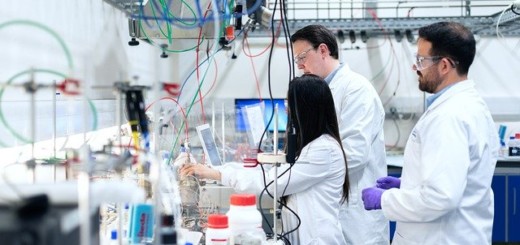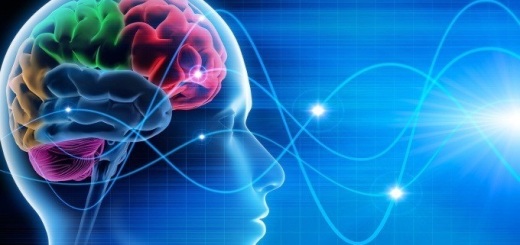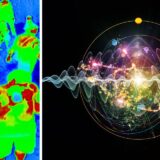Misurato per la prima volta l’effetto Hall anomalo della luce

I ricercatori del Cnr-Nanotec di Lecce hanno dimostrato in un lavoro pubblicato su Nature che un fotone devia lateralmente dalla sua traiettoria dovuta alla curvatura topologica della sua dispersione energetica, come se rotolando lungo un pendio sentisse il vento soffiare in direzioni opposte a seconda della sua polarizzazione
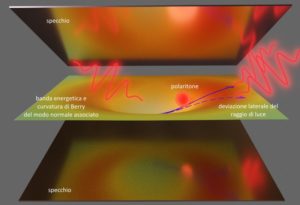
Roma, 2 luglio 2020 – È noto che gli elettroni sono trascinati lungo la direzione di un campo elettrico che agisce sulla loro carica, mentre un campo magnetico li devia lateralmente rispetto alla loro traiettoria (effetto Hall). Nel caso per esempio dei cristalli, però, le proprietà geometriche e più precisamente topologiche delle bande energetiche (bande elettroniche, la gamma di energie e di velocità che un elettrone può assumere all’interno di un materiale) influiscono sul moto stesso degli elettroni, permettendo l’osservazione di effetti altrimenti inspiegabili come l’effetto Hall anomalo, in cui la traiettoria di un elettrone viene deviata lateralmente, come se ci fosse un “campo magnetico artificiale”.
Tuttavia, la topologia è fondamentale non solo per la dinamica elettronica, ma anche per la propagazione della luce: in strutture fotoniche, molti effetti sono dovuti proprio alla topologia delle bande energetiche dei fotoni. Ad esempio, sono basati sulla topologia gli isolatori micro-ottici, dispositivi chiave per la realizzazione di circuiti fotonici integrati, e i laser topologici, la cui stabilità è garantita dalla “protezione topologica” dei cosiddetti “edge states”.
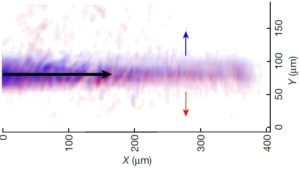
Ricercatori dell’Istituto di nanotecnologia del Consiglio nazionale delle ricerche (Cnr-Nanotec) di Lecce, insieme a colleghi dell’Istituto Pascal del CNRS e della UCA a Clermond Ferrand in Francia e della Princeton University negli Usa, in un lavoro pubblicato su “Nature”, hanno dimostrato la prima mappatura diretta della curvatura locale in una banda energetica di particelle ibride di luce e materia, chiamate “polaritoni”.
Grazie a questa ‘curvatura’ i ricercatori del Cnr-Nanotec sono riusciti ad osservare un drift anomalo (deviazione laterale) paragonabile all’effetto Hall, generato da una proprietà geometrica della banda energetica anziché da un campo magnetico esterno. Questo dimostra l’effetto Hall anomalo nella propagazione di luce invece che di elettroni, generato da un campo magnetico ‘sintetico’ che agisce appunto sui fotoni, particelle globalmente neutre.
“La topologia ha a che fare con la conservazione di grandezze un poco meno familiari dell’energia o della massa – dice Lorenzo Dominici, coautore del lavoro e ricercatore Cnr-Nanotec – Un esempio è la caratteristica di Eulero, che ci dice cosa hanno in comune un dado ed una piramide. La caratteristica condivisa è il numero totale dei vertici e delle facce meno quello degli spigoli. Numero che è pari a due come per ogni altro poliedro chiuso. Questo numero intero si conserva anche se si deforma il poliedro aggiungendo facce fino a renderlo un solido liscio, senza spigoli ne vertici, ma in tal caso per calcolarlo si deve considerare la curvatura precisa in ogni punto della superficie”.
L’esistenza di proprietà geometriche invarianti per piccole deformazioni arricchisce l’idea di un Universo geometrico, concepita da Einstein quasi un secolo fa e la topologia rappresenta un campo di ricerca della matematica moderna sviluppatosi a partire dalla connessione tra le proprietà topologiche delle bande energetiche e le proprietà macroscopiche di conduzione elettrica dei solidi.
“Queste proprietà topologiche possono sembrare astrazioni, tuttavia sono un campo di grande interesse per i fisici – aggiunge Dario Ballarini, altro coautore e ricercatore Cnr-Nanotec – Per esempio i fisici agli albori della quantistica avevano capito che i livelli energetici degli atomi sono discretizzati perché il numero di giravolte su sé stesso che l’elettrone deve fare mentre gira intorno al nucleo deve essere intero”.
“Abbiamo studiato un fluido ibrido composto da elettroni e fotoni intrappolato tra due specchi altamente riflettenti – proseguono Guillame Malpuech e Dmitry Solnyshkov, i coautori dell’Istituto Pascal – Come avevamo previsto teoricamente alcuni anni fa, combinando le asimmetrie interne della struttura con quelle indotte da un campo magnetico esterno che agisce sulle bande elettroniche del materiale, i colleghi di Lecce hanno potuto osservare l’emergere della curvatura detta “di Berry“ in uno spazio delle velocità, ovvero in una zona circolare sulla banda energetica di questo fluido. Grazie alla generazione e rilevazione ottica di queste particelle di luce si è ottenuta la prima mappatura diretta di tale curvatura ed è stata sperimentalmente osservata la deviazione anomala delle particelle accelerate nel dispositivo”.
“Questi risultati sono stati raggiunti grazie a una piattaforma di ‘luce liquida’ che combina le alte interazioni degli elettroni con l’alta coerenza e facile controllo della luce – conclude Daniele Sanvitto, coordinatore del gruppo sperimentale – Tali fluidi di luce ci hanno già permesso di studiare interessanti fenomenologie dei fluidi quantici come i condensati di Bose Einstein, che hanno mostrato la formazione di un superfluido a temperatura ambiente, capace di oltrepassare ostacoli senza attrito, la comparsa di vortici quantici e di X-waves. Oltre che per la computazione ottica o per le reti neurali del futuro, tali osservazioni aprono ampie prospettive per la fisica topologica e l’opportunità di unire la topologia con la non linearità al fine di simulare fenomeni impossibili da osservare direttamente in altri campi, come la cosmologia o la fisica delle alte energie”.
Fig. 1 – Il fascio di luce incidente è convertito in un fascio interno di polaritoni che è deviato dalla curvatura geometrica nello spazio delle bande energetiche del sistema, prima di essere riemesso come fotoni. Questa deviazione è simile a quella causata dal campo magnetico su elettroni in movimento, pur avendo i polaritoni carica elettrica totale nulla. Crediti: gli autori.
Fig. 2 – Il fascio di polaritoni con diversa polarizzazione (blu e rossa) propaga accelerato nello spazio interno al dispositivo (verso destra, freccia nera) ed è deviato lateralmente in senso opposto (alto e basso, freccia blu e rossa) a seconda della curvatura che agisce sulla sua carica vettoriale (cioè sulla sua polarizzazione). Crediti: il giornale.
*******
First measurement of the Anomalous Hall effect of a light beam
Researchers from Cnr-Nanotecin Lecce have demonstrated in a work published on Nature that a photon beam can drift laterally from its trajectory due to the topological curvature of its energy band, like if rolling on a cliff it could feel a different wind depending on its polarization state
Everybody knows that electrons in any material can be dragged by an electric field acting on their charge, while a magnetic field, instead, make them deviate orthogonally to the electrons trajectory (Hall effect). This is the essence of electrodynamics, but it’s not the whole story. In the case of crystals, for instance, the geometric properties or more precisely the topology of the energy bands (the electronic bands, the set of energies and velocities that electrons can acquire at the interior of a material) do influence their movement, allowing for very interesting effects such as the observation of the well-known quantum Hall effect, where the trajectory of the electron is bent laterally as in the presence of an “artificial magnetic field”.
However, topological concepts go beyond the more common electronic dynamics being fundamental also for the propagation of light: in photonic devices, for example, many effects can be traced back to the topology of the energy bands structure of photons. Examples of topology based photonic devices are micro-optical isolators, one-way key elements to the realization of fast integrated computing platforms and topological lasers, whose stability is provided by the “topological protection” of so called “edge states”.
Researchers from the CNR Nanotec Lecce in Italy together with the theorists of the Institut Pascal of the UCA-CNRS in Clermont Ferrand, France, and the Princeton University in USA, have demonstrated, in a work published in Nature, the first direct mapping of the local curvature in a band of a hybrid light-matter particle, called “polaritons”.
Thanks to this ‘curvature’ the researchers from Cnr-Nanotec have observed an anomalous lateral drift similar to the Hall effect, induced by a geometrical property of the energy band rather than directly due to an external magnetic field. This demonstrates the anomalous Hall effect in the photonic propagation instead than in the electrons movement, and the effect of a synthetic magnetic field, acting on the photons, despite these being globally neutral particles.
“Topology deals with conservation of quantities which are somehow unfamiliar compared, for example, to energy or mass – says Lorenzo Dominici, one of the researchers of the team working in the CNR laboratories in Lecce – One example is the Euler characteristic, which tells us what is the common feature between a dice and a pyramid. That feature is simply the number of vertices and faces minus that of the edges, which is equal to two, similarly to any other closed polyhedron. This integer number is preserved even if one would bend continuously the polyhedron into a smooth solid, without vertices and edges, but to compute that number, you now need to consider the precise curvature at any given point of the surface”.
The existence of properties which are invariant for little deformationsis a topological concept which enriches the fundamental idea that the essence of the universe is geometric, as archetypically conceived by Einstein almost a century ago. As a matter of fact, topology represents a whole research field of modern mathematics which enormously developed since when researchers found that the shape of the energy bands is pivotal in controlling the macroscopic conduction properties in solids.
“These topological properties may look as a mere abstraction, however it is a field of strong interest for the physics community – says Dario Ballarini, a researcher also working at laboratories in Lecce – For example at the early days of quantum physics, the scientists understood that the energy levels of the atoms are discrete because the electron has to do an integer number of twists on itself while rotating around the nucleus”.
“We studied an hybrid fluid made of electrons and photons trapped in between two highly reflecting mirrors – say Guillame Malpuech and Dmitry Solnyshkov, the coauthors working at CNRS Institut Pascal in Clermont-Ferrand – As we predicted theoretically few years ago, combining the internal asymmetries of the device structure with those induced by an external magnetic field, acting on the electronic bands of the material, our colleagues in Lecce could see the emergence of the so called “Berry” curvature in the space of the velocities, which is on a circular area of the energy band of this fluid. By taking advantage of the all-optical generation and detection of these hybrid particles of light, it has been possible to retrieve the first direct mapping of the curvature of such curvature. Furthermore, as predicted by a semi-classical model, it was observed an anomalous drift of the polariton particles accelerated inside the device”.
“These results have been reached thanks to a very interesting platform made of ‘liquid light’ which benefits from the qualities of both electrons, having strong interactions, and light, showing high coherence and optical control – says Daniele Sanvitto, coordinator of the experimental team – Such fluids of light had already allowed us to study very interesting phenomenon, typical of quantum fluids–such as Bose-Einstein condensates–leading to observations of superfluid at room temperature, capable of passing obstacles without feeling friction, the appearance of quantized vortices, playing a pivotal role in the long distance topological order of these fluids, and localized X-waves packets. Apart from being promising for optical computation or future neural networks, they open up wide perspectives for topological physics, such as photonic insulators and topological lasers, as well as opportunities in mixing topology with nonlinearity for simulating phenomena otherwise impossible to directly observe in other fields, such as cosmology or high energy physics”.
Fig. 1 – The incident light beam is converted in the internal beam of polaritons which is deviated by the geometrical curvature present in the space of the energy bands of the hybrid photonic system, before being reemitted as photons. This drift is quite similar with the one caused by the magnetic field on moving electrons, despite the polaritons being neutral particles, with a zero total electric charge. Credits: the authors.
Fig. 2 – The polariton beams with different polarization(blue and red) propagate inside the device (to the right, black arrow) and are laterally bent in opposite directions (up and down, blue and red arrows), depending on the different curvature acting on their vector charge (which is, on their polarization). Credits: the journal.

